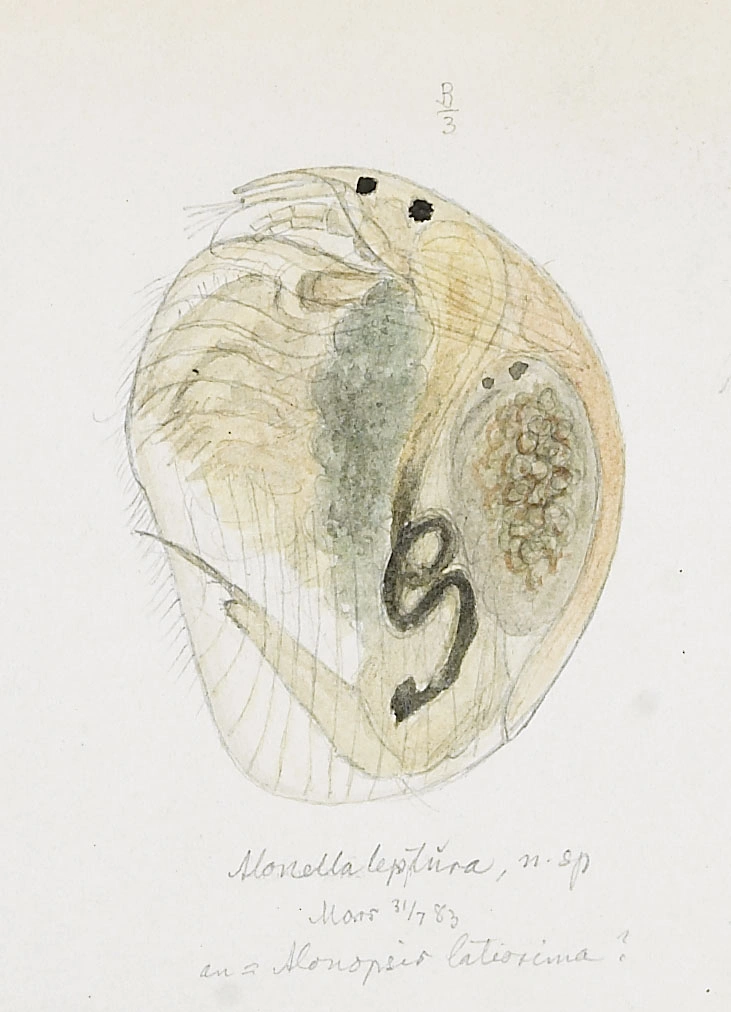Kurzia latissima
Kurzia latissima is a rare species, which lives close to the bottom sediment. The post abdomen is tapering evenly towards the end, where there are three long denticles.
Key characteristics
Kurzia latissima (female)
Originally Kurz included K. latissima in the genus Alonopsis. Sars found similarities with the genus Alonella and described it to that genus. Seen from the side, however, it shows similarities with Alona sp, because the posterior margin of the valve is more than half the maximum height. The rostrum is short and the antennae are long and slender. The postabdomen is tapering evenly towards the end, where there are three denticles comparatively longer than the rest of the denticles situated on the posterior edge. The abdominal claw has a row of small hair with one short bristle at the middle. The colour is varying including grey, yellow, brown and red colours.
Female: Length 0.4–0.6 mm
Male: Length 0.4–0.5 mm
Ecology and distribution
K. latissima is a littoral species, which has only been found in a few localities (0.3 %). Except for one record from a lake 200 km south of Oslo, all are from the vicinity of Oslo. G.O. Sars also found the species twice in the same area. Records of K. latissima are from water bodies of different size (0.002–165 da), situated between see level and 600 m a.s.l. pH varies between 4.3 and 7.3 while conductivity is within the range 2.0 and 10.2 mS/m.
| Vitenskapelig navn | < 4,5 | 4,5 - 4,9 | 5,0 - 5,4 | 5,5 - 5,9 | 6,0 - 6,4 | 6,5 - 7,0 | 7,0 - 7,4 | > 7,5 |
|---|---|---|---|---|---|---|---|---|
| 1 | 0,4 | 0,4 | 0 | 0,3 | 0,5 | 0,4 | 0 |
| Vitenskapelig navn | < 1,0 | 1,0 - 1,4 | 1,5 - 1,9 | 2,0 - 2,9 | 3,0 - 3,9 | 4,0 - 4,9 | 5,0 - 6,9 | 7,0 - 9,9 | > 10,0 |
|---|---|---|---|---|---|---|---|---|---|
| 0 | 0 | 0 | 1,3 | 0,4 | 0,6 | 0,6 | 0 | 0,4 |
| Vitenskapelig navn | < 0,01 | 0,01 - 0,09 | 0,1 - 0,9 | 1,0 - 9,9 | 10,0 - 99 | 100 - 999 | > 1000 |
|---|---|---|---|---|---|---|---|
| 2 | 0,5 | 0 | 0,5 | 0,1 | 0,3 | 0 |
| Vitenskapelig navn | < 100 | 100-299 | 300-499 | 500-699 | 700-999 | >1000 |
|---|---|---|---|---|---|---|
| 0,4 | 0,2 | 0 | 1,4 | 0 | 0 |
